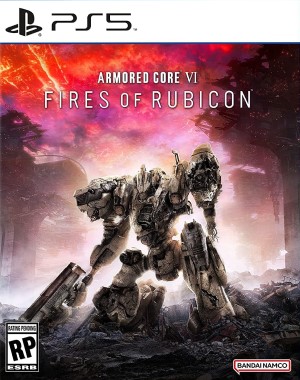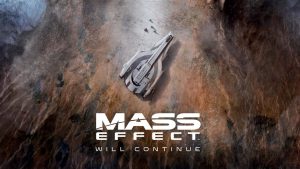
With FromSoft refining their expertise in the decade-plus since Armored Core V, Fires of Rubicon is shaping up to be a soft reboot of the mech battling series. Indeed, the design principles FromSoftware has established in their catalogue are present and correct in Armored Core 6: smooth controls with swift response to player input and actions, expansive, dynamic maps filled with an ever-present sense of progression, and challenging battles requiring player ingenuity to survive are – if gameplay previews shared by FromSoftware producer Yasunori Ogura are anything to go by – amalgamating seamlessly with the unique feel of mecha-based combat.
And if it wasn’t for Yasunori Ogura’s gameplay snippets shared during Summer Games Fest, we wouldn’t have an awful lot of footage to go off, as FromSoft have taken the unorthodox approach of showcasing the bulk of Armored Core 6’s gameplay at invite only behind closed doors events. A questionable marketing strategy, perhaps, but the Tokyo-headquartered studio have built up a lot of goodwill from its fanbase with the runaway successes of Elden Ring, Sekiro: Shadows Die Twice, Bloodborne, and not to mention the Dark Souls trilogy, that hype would still be at fever pitch had they not shown any Fires of Rubicon gameplay up to now. But, as it happens, any concerns Armored Core 6 is just Dark Souls with robots have been well and truly quashed with Ogura’s five-or-so minute foray through remote planet Rubicon 3’s industrial battlegrounds.
Make no mistake, Armored Core 6’s action looks fast and ferocious with the demo also highlighting a tactical element underpinned by extensive customisation; the variety on offer in mech assembly inevitably leading to numerous playstyles and approaches to completing Fires of Rubicon’s missions. Whilst Armored Core 6 eschews open-world design in favour of linear level structure, there’s certainly no sense of linearity here. Vast, open spaces can be traversed a multitude of ways depending on mech loadout: equip a mech with aerial boosters and lightweight weaponry to glide across huge chasms instantaneously or weigh down with heavy artillery to forge a way across on foot or via bridges instead. There’s a grand sense of scale in Rubicon 3’s rusted foundries with FromSoftware evidently placing much emphasis on verticality; upwards, diagonal, and side to side movement are just as important as grounded horizontal. The widescreen panorama of disused factories and industrial wasteland contrasts nicely with compact, claustrophobic corridors too, requiring players make ample use of their mech’s strafing ability to navigate through twisting metal trouble-free.
We do get a close if limited look at some of the customisations on offer in Armored Core 6’s gameplay preview: it appears mechs can be equipped with up to four weapons and shields across arms and shoulders. We see glimpses of melee and ranged weaponry: laser daggers, missile launchers, and multi lock-on rockets. Leg augmentations appear to influence traversal in exchange for defensive capability. For instance, the lightweight bi-pedal crawler or reverse joint seem to sacrifice stability and defence to maximise jumping, agility, and dodging capability. Intriguingly, back-mounted power generators balance raw power with overall mech weight, and there’re generators capable of powering specific types of weapons only. The sheer number of stats, meters, parts, and gauges and how they all interact with each other risks overwhelming some, but one thing is for sure: mech loadouts will constantly be in flux. Players will be forced to make consistent trade-offs between firepower, defence, mobility, and power when specifying their killing machines, and as this has been a draw of the series from day one it’ll likely prove a fruitful endeavour for most.
Don’t forget this is a FromSoftware title, so expect enemies to pose a tough test with the familiar premise of learning attack patterns necessary to survival; mech loadouts provide players plenty of creativity in this regard though. Long-range scanners can highlight enemy placement with the possibility of bulky ordinance clearing out swathes of territory from distance, or perhaps the ruthlessness of a mech armed to the teeth with vicious melee weapons could swiftly strafe between opponents, speedily slicing multiple enemies down hack and slash style. Player choice really does seem front and centre, although it must be said from the gameplay shared thus far a blend of gunpower with hand-to-hand weaponry appears most optimal due to the especially powerful thwack of melee swords and laser daggers.
Owing to Armored Core 6’s Sekiro: Shadows Die Twice style stagger meter, a fluid combination of dodging, shooting, strafing, stunning, then scything looks to be the most satisfactory way to destroy an opposing mech. An emphasis on boss battles represents another deviation for the series, with a colossal molten metal spewing tank the most threatening test of dodging skill present in Armored Core 6’s gameplay previews.
Whether players will eventually gravitate towards an all-rounder to see them through Fires of Rubicon’s storyline, or whether they’ll be forced to make mech alterations mid-mission remains to be seen, but it’s a tantalising prospect to land on a loadout suited to individual playstyle as much as one demanded by Rubicon 3’s layout and boss encounters.
And just a quick word on Fires of Rubicon’s level design: this is an organic world of rocky, Earth-like terrain overgrown by metal, shards, and pipework, all corroded and grey. These are bleak, cold industrial landscapes beautifully imagined, with sharp lighting and sparing use of colour providing a glimmer of interest to what could have easily been an overly monotone setting. The intricacy of Rubicon 3, functionally designed yet minimal, is a triumph; FromSoftware’s environment artists deserve huge kudos. Likewise, Armored Core 6’s sound design team deserve praise too, not just for the piercing, rip-roaring explosions, and jetpack sound effects punctuating the barren wasteland, but for the pulsating soundtrack performed by in-house music band FreQuency too, comprising members of the sound team plus Armored Core composer Kota Hoshino.
FromSoftware, and indeed publisher Bandai Namco, have been very clear in stating Armored Core 6: Fires of Rubicon is not a Soulslike. Yes, Armored Core 6’s design philosophy shares a lot of common ground with FromSoft mainstays Dark Souls and Bloodborne, but movement, weaponry, and setting evoke something distinct from FromSoft’s usual fayre. Sure, the satisfaction of overcoming the stress and frustration of a seemingly impossible situation – a major selling point for Soulslike fans – takes precedence in Fires of Rubicon too, but the game’s producer Yasunori Ogura stresses Armored Core 6 seeks to modernise the Armored Core formula by leveraging elements from their dark fantasy RPGs. It’ll share connective tissue with Dark Souls for sure – firm but fair combat for one – but Armored Core 6: Fires of Rubicon is very much its own thing.
Launching August 25th to PlayStation 4 and 5 (with a free upgrade from PS4 to PS5), Xbox Series X|S and Xbox One, plus PC via Steam, Armored Core 6: Fires of Rubicon is set to be one of the biggest games of the year, not by default, but because the prospect of FromSoftware turning back the clock to reinvigorate and revitalise their formative series with modern knowhow is too tantalising to ignore.
Note: The views expressed in this article are those of the author and do not necessarily represent the views of, and should not be attributed to, GamingBolt as an organization.















